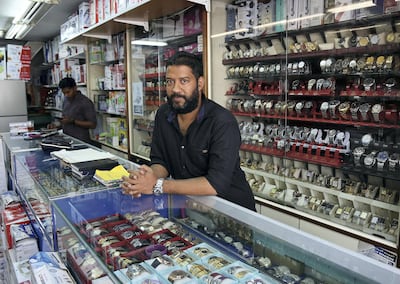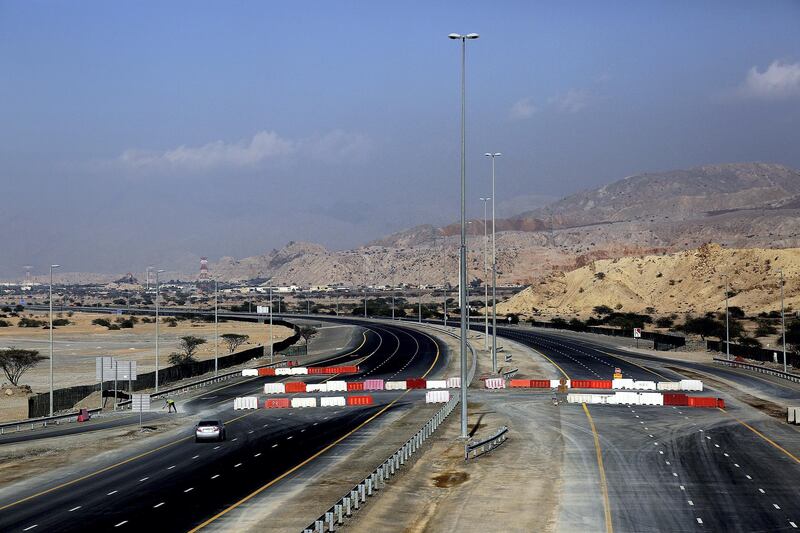Ali Al Shemaili says Ras Al Khaimah’s 32-kilometre ring road has cut 40 minutes from his weekly commute to Abu Dhabi – but it has also cut his community of Shimal in half.
The bypass connects the E311 motorway from the southern desert suburbs with north-coast villages, Saqr port, quarries and cement factories.
The three-lane motorway has long been considered crucial to reducing the industrial traffic that clogs Ras Al Khaimah’s downtown roads, and linking northern communities to Dubai and Abu Dhabi.
The RAK Ring Road has only officially opened along the section that runs from the E311 at Exit 126, but it comes amid a push for better road infrastructure, including to the north.
Last week, The National reported on how crippling traffic between Sharjah and Dubai is putting a strain on businesses in the surrounding areas as customers seek to avoid the gridlock. Earlier in the month, it was also revealed in a global study that the average Dubai commuter spent 29 hours stuck in rush hour traffic last year, which is the equivalent of about three working days.
And in February, FNC member Abdullah Al Mehrezi named a number of roads in the northern emirates that have been suffering from a lack of attention for decades.
In RAK, residents are already cruising down parts of its unpainted tarmac making the most of the new, shorter route to the southern Awafi desert. There have been fatal crashes on the closed road, prompting Ras Al Khaimah police to install radar.
''The RAK Ring Road once completed will reduce travel time for vehicles to the emirate by more than 30 percent and will serve the emirate for the next 30 years,'' said Dr Abdullah Al Nuaimi, the Minister of Infrastructure Development.
Over the years, media have announced that the road will be complete by 2010, 2014, 2016, 2018 and 2020. Last month, the Ministry of Infrastructure announced that the road’s Dh90-million second phase – the whole project is scheduled to cost Dh398m – is expected to be finished during the second quarter of 2018.
It will reduce traffic in Ras Al Khaimah city by a third and cut the drive to or from Dubai by up to an hour.
In the six years since road project started, however, the emirate has already transformed in ways the planners could not have foreseen in response to population growth. The road that was once intended to circumnavigated the city will now become a part of it. Its construction has changed the communities it intersects, for better and for worse.
The ring road begins at the northerly end at Shimal, a village 30km south of Oman’s Musandam border. During construction, its residents negotiated with the state through the traditional majlis system, where citizens meet decision makers to discuss policy.
Negotiations over compensation resulted in delays during 2014, local media reported at the time. For citizens, the ability to negotiate directly with their government through the majlis system was an exercise in political engagement and an important process in the road’s construction.
Mr Al Shemaili, unsatisfied with an offer of Dh300,000 in compensation, made regular visits to the royal courts in Abu Dhabi and Ras Al Khaimah, in addition to the local municipality, where the director general, Munther Al Zaabi, opens his office to the public twice a week. “I told them, ‘I don’t need money. I want land.’ So Munther told me, ‘Ok, where do you want land?’”
Resolving the damage from the construction has not been so easy for everyone. Following delays to the proposed ring road construction, the main road of Al Nakheel, an area south of Shimal, was worn down, eventually closing for two years of repairs due to heavy lorries rattling through carrying cement, boulders and aggregate.
The municipality and the ministry had no one available to comment.
“When the road was closed, business dropped by a quarter,” said Shameer Mohammed, 37, a shopkeeper who joined his father’s business 17 years ago. “During the time of the roadworks, it was not possible for customers to come here.”

______________
Read more:
More needs to be done to improve UAE roads, FNC members say
______________
The road’s closure also coincided with the rise of the shopping mall. Today, the neighbourhood, once popular with tourists, has shuttered shops and the market is now almost exclusively a place for South-Asian workers with limited disposable income.
According to retailers, sales have halved and rent has increased up to 65 per cent since the road reopened two years ago.
The population of Ras Al Khaimah has shifted south over the last six years to integrated residential developments in Jazirat Al Hamra and to the sprawling desert suburbs of Khalifa bin Zayed City and Mohammed bin Zayed City, where thousands of Emirati families moved in the government-funded housing boom that followed Sheikh Mohammed’s February 2011 northern emirates tour.
The city has already expanded 5km into the desert, reaching the dunes that were once far from the city’s edge. It remains to be seen what the next 30 years will hold and if the road’s use will last that long.






